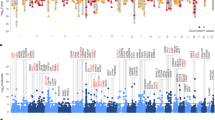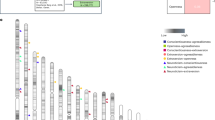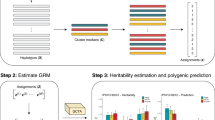Abstract
Decision making, choosing the best option from the possible outcomes, is impaired in many psychiatric conditions including affective disorders. We tested the hypothesis that variations in serotonergic genes (TPH2, TPH1, SLC6A4, HTR1A), which influence serotonin availability, affect choice behavior in a probabilistic gambling task. A population cohort (N=1035) completed a paper-and-pencil gambling task, filled out personality and symptom questionnaires and gave consent for the use of their DNA in a genetic association study. A subgroup of subjects (N=69) also completed a computer version of the task. The gambling task was designed to estimate an individual's tendency to take a risk when choosing between a smaller but more certain ‘win’ and a larger, less probable one. We genotyped seven haplotype tagging SNPs in the TPH2 gene, and previously reported functional polymorphisms from the other genes (rs1800532, 5HTTLPR, and rs6295). Carriers of the more prevalent TPH2 haplotype, which was previously associated with less active enzyme variant, showed reduced risk taking on both tasks compared with subjects not carrying the common haplotype. The effect of TPH2 haplotypes on risk-taking was independent of current depression and anxiety symptoms, neuroticism and impulsiveness scores. We did not find an association between functional polymorphisms in the TPH1, SLC6A4, HTR1A genes and risk-taking behavior. In conclusion, our study demonstrates the role of the TPH2 gene and the serotonin system in risk taking and suggests that TPH2 gene may contribute to the expression of psychiatric phenotypes through altered decision making.
Similar content being viewed by others
Log in or create a free account to read this content
Gain free access to this article, as well as selected content from this journal and more on nature.com
or
References
American Psychiatric Association (2000). Diagnostic and Statistical Manual of Mental Disorders 4th edn. Text Revision (DSM-IV-TR) American Psychiatric Association: Arlington, VA.
Anderson IM, Richell RA, Bradshaw CM (2003). The effect of acute tryptophan depletion on probabilistic choice. J Psychopharmacol 17: 3–7.
Barrett JC, Fry B, Maller J, Daly MJ (2005). Haploview: analysis and visualization of LD and haplotype maps. Bioinformatics 21: 263–265.
Bechara A, Dolan S, Hindes A (2002). Decision-making and addiction (part II): myopia for the future or hypersensitivity to reward? Neuropsychologia 40: 1690–1705.
Bernstein DP, Fink L, Handelsman L, Foote J, Lovejoy M, Wenzel K et al (1994). Initial reliability and validity of a new retrospective measure of child abuse and neglect. Am J Psychiatry 151: 1132–1136.
Blair KS, Finger E, Marsh AA, Morton J, Mondillo K, Buzas B et al (2008). The role of 5-HTTLPR in choosing the lesser of two evils, the better of two goods: examining the impact of 5-HTTLPR genotype and tryptophan depletion in object choice. Psychopharmacology (Berl) 196: 29–38.
Brown SM, Peet E, Manuck SB, Williamson DE, Dahl RE, Ferrell RE et al (2005). A regulatory variant of the human tryptophan hydroxylase-2 gene biases amygdala reactivity. Mol Psychiatry 10: 884–888, 805.
Brugha T, Bebbington P, Tennant C, Hurry J (1985). The List of Threatening Experiences: a subset of 12 life event categories with considerable long-term contextual threat. Psychol Med 15: 189–194.
Canli T, Congdon E, Gutknecht L, Constable RT, Lesch KP (2005). Amygdala responsiveness is modulated by tryptophan hydroxylase-2 gene variation. J Neural Transm 112: 1479–1485.
Cardinal RN (2006). Neural systems implicated in delayed and probabilistic reinforcement. Neural Netw 19: 1277–1301.
Chen GL, Miller GM (2008). Rhesus monkey tryptophan hydroxylase-2 coding region haplotypes affect mRNA stability. Neuroscience 155: 485–491.
Chen GL, Vallender EJ, Miller GM (2008). Functional characterization of the human TPH2 5′ regulatory region: untranslated region and polymorphisms modulate gene expression in vitro. Hum Genet 122: 645–657.
Cooper ML, Agocha VB, Sheldon MS (2000). A motivational perspective on risky behaviors: the role of personality and affect regulatory processes. J Pers 68: 1059–1088.
Costa Jr PT, McCrae RR (1992). Revised NEO Personality Inventory (NEO-PI–R) and NEO Five-Factor Inventory (NEO-FFI) Professional Manual. Psychological Assessment Resources: Odessa, FL.
Crean JP, de Wit H, Richards JB (2000). Reward discounting as a measure of impulsive behavior in a psychiatric outpatient population. Exp Clin Psychopharmacol 8: 155–162.
De Luca V, Hlousek D, Likhodi O, Van Tol HH, Kennedy JL, Wong AH (2006). The interaction between TPH2 promoter haplotypes and clinical-demographic risk factors in suicide victims with major psychoses. Genes Brain Behav 5: 107–110.
Derogatis LR (1993). BSI: Brief Symptom Inventory: Administration, Scoring, and Procedures Manual. National Computer Systems Pearson Inc.: Minneapolis.
Dolan M, Anderson IM, Deakin JF (2001). Relationship between 5-HT function and impulsivity and aggression in male offenders with personality disorders. Br J Psychiatry 178: 352–359.
Elliott R, Deakin B (2005). Role of the orbitofrontal cortex in reinforcement processing and inhibitory control: evidence from functional magnetic resonance imaging studies in healthy human subjects. Int Rev Neurobiol 65: 89–116.
Elliott R, Sahakian BJ, Herrod JJ, Robbins TW, Paykel ES (1997). Abnormal response to negative feedback in unipolar depression: evidence for a diagnosis specific impairment. J Neurol Neurosurg Psychiatry 63: 74–82.
Eysenck SB, Eysenck HJ (1978). Impulsiveness and venturesomeness: their position in a dimensional system of personality description. Psychol Rep 43: 1247–1255.
Forbes EE, Christopher MJ, Siegle GJ, Ladouceur CD, Ryan ND, Carter CS et al (2006). Reward-related decision-making in pediatric major depressive disorder: an fMRI study. J Child Psychol Psychiatry 47: 1031–1040.
Freeman B, Smith N, Curtis C, Huckett L, Mill J, Craig IW (2003). DNA from buccal swabs recruited by mail: evaluation of storage effects on long-term stability and suitability for multiplex polymerase chain reaction genotyping. Behav Genet 33: 67–72.
Gabriel SB, Schaffner SF, Nguyen H, Moore JM, Roy J, Blumenstiel B et al (2002). The structure of haplotype blocks in the human genome. Science 296: 2225–2229.
Gutknecht L, Jacob C, Strobel A, Kriegebaum C, Muller J, Zeng Y et al (2007). Tryptophan hydroxylase-2 gene variation influences personality traits and disorders related to emotional dysregulation. Int J Neuropsychopharmacol 10: 309–320.
Gutknecht L, Waider J, Kraft S, Kriegebaum C, Holtmann B, Reif A et al (2008). Deficiency of brain 5-HT synthesis but serotonergic neuron formation in Tph2 knockout mice. J Neural Transm 115: 1127–1132.
Haghighi F, Bach-Mizrachi H, Huang YY, Arango V, Shi S, Dwork AJ et al (2008). Genetic architecture of the human tryptophan hydroxylase 2 gene: existence of neural isoforms and relevance for major depression. Mol Psychiatry 13: 813–820.
Hinvest NS, Anderson IM (2009). The effects of real vs hypothetical reward on delay and probability discounting. Q J Exper Psychol 29: 1–13.
Ho MY, Mobini S, Chiang TJ, Bradshaw CM, Szabadi E (1999). Theory and method in the quantitative analysis of ‘impulsive choice’ behaviour: implications for psychopharmacology. Psychopharmacology (Berl) 146: 362–372.
Holt DD, Green L, Myerson J (2003). Is discounting impulsive?. Evidence from temporal and probability discounting in gambling and non-gambling college students. Behav Processes 64: 355–367.
Homberg JR, van den BR, den Heijer E, Suer R, Cuppen E (2008). Serotonin transporter dosage modulates long-term decision-making in rat and human. Neuropharmacology 55: 80–84.
Hunt IM, Silman AJ, Benjamin S, McBeth J, Macfarlane GJ (1999). The prevalence and associated features of chronic widespread pain in the community using the ‘Manchester’ definition of chronic widespread pain. Rheumatology (Oxford) 38: 275–279.
John OP, Donahue EM, Kentle RL (1991). The Big Five Inventory-Versions 4a and 54. University of California, Berkeley, Institute of Personality and Social Research: Berkeley.
Jollant F, Buresi C, Guillaume S, Jaussent I, Bellivier F, Leboyer M et al (2007). The influence of four serotonin-related genes on decision-making in suicide attempters. Am J Med Genet B Neuropsychiatr Genet 144: 615–624.
Juhasz G, Chase D, Pegg E, Downey D, Toth ZG, Stones K et al (2009). CNR1 Gene is associated with high neuroticism and low agreeableness and interacts with recent Negative Life Events to predict current depressive symptoms. Neuropsychopharmacology 34: 2019–2027.
Ke L, Qi ZY, Ping Y, Ren CY (2006). Effect of SNP at position 40237 in exon 7 of the TPH2 gene on susceptibility to suicide. Brain Res 1122: 24–26.
Lemonde S, Turecki G, Bakish D, Du L, Hrdina PD, Bown CD et al (2003). Impaired repression at a 5-hydroxytryptamine 1A receptor gene polymorphism associated with major depression and suicide. J Neurosci 23: 8788–8799.
Lesch KP, Bengel D, Heils A, Sabol SZ, Greenberg BD, Petri S et al (1996). Association of anxiety-related traits with a polymorphism in the serotonin transporter gene regulatory region. Science 274: 1527–1531.
Li D, He L (2006). Further clarification of the contribution of the tryptophan hydroxylase (TPH) gene to suicidal behavior using systematic allelic and genotypic meta-analyses. Hum Genet 119: 233–240.
Lim JE, Pinsonneault J, Sadee W, Saffen D (2007). Tryptophan hydroxylase 2 (TPH2) haplotypes predict levels of TPH2 mRNA expression in human pons. Mol Psychiatry 12: 491–501.
Lin YM, Chao SC, Chen TM, Lai TJ, Chen JS, Sun HS (2007). Association of functional polymorphisms of the human tryptophan hydroxylase 2 gene with risk for bipolar disorder in Han Chinese. Arch Gen Psychiatry 64: 1015–1024.
Lopez dL, Brezo J, Rouleau G, Lesage A, Dumont M, Alda M et al (2007a). Effect of tryptophan hydroxylase-2 gene variants on suicide risk in major depression. Biol Psychiatry 62: 72–80.
Lopez VA, Detera-Wadleigh S, Cardona I, Kassem L, McMahon FJ (2007b). Nested association between genetic variation in tryptophan hydroxylase II, bipolar affective disorder, and suicide attempts. Biol Psychiatry 61: 181–186.
Mann JJ, Currier D, Murphy L, Huang YY, Galfalvy H, Brent D et al (2008). No association between a TPH2 promoter polymorphism and mood disorders or monoamine turnover. J Affect Disord 106: 117–121.
Mobini S, Chiang TJ, Ho MY, Bradshaw CM, Szabadi E (2000). Effects of central 5-hydroxytryptamine depletion on sensitivity to delayed and probabilistic reinforcement. Psychopharmacology (Berl) 152: 390–397.
Munafo MR, Freimer NB, Ng W, Ophoff R, Veijola J, Miettunen J et al (2009). 5-HTTLPR genotype and anxiety-related personality traits: a meta-analysis and new data. Am J Med Genet B Neuropsychiatr Genet 150B: 271–281.
Murphy SE, Longhitano C, Ayres RE, Cowen PJ, Harmer CJ, Rogers RD (2008). The role of serotonin in nonnormative risky choice: the effects of tryptophan supplements on loss-aversion in healthy adult volunteers. J Cogn Neurosci 21: 1709–1719.
Must A, Juhasz A, Rimanoczy A, Szabo Z, Keri S, Janka Z (2007). Major depressive disorder, serotonin transporter, and personality traits: why patients use suboptimal decision-making strategies? J Affect Disord 103: 273–276.
Ono H, Shirakawa O, Kitamura N, Hashimoto T, Nishiguchi N, Nishimura A et al (2002). Tryptophan hydroxylase immunoreactivity is altered by the genetic variation in postmortem brain samples of both suicide victims and controls. Mol Psychiatry 7: 1127–1132.
Paulus MP (2007). Decision-making dysfunctions in psychiatry--altered homeostatic processing? Science 318: 602–606.
Paulus MP, Rogalsky C, Simmons A, Feinstein JS, Stein MB (2003). Increased activation in the right insula during risk-taking decision making is related to harm avoidance and neuroticism. Neuroimage 19: 1439–1448.
Rachlin H, Logue AW, Gibbon J, Frankel M (1986). Cognition and behavior in studies of choice. Psychol Rev 93: 33–45.
Reuter M, Kuepper Y, Hennig J (2007). Association between a polymorphism in the promoter region of the TPH2 gene and the personality trait of harm avoidance. Int J Neuropsychopharmacol 10: 401–404.
Rijsdijk FV, Sham PC, Sterne A, Purcell S, McGuffin P, Farmer A et al (2001). Life events and depression in a community sample of siblings. Psychol Med 31: 401–410.
Rogers RD, Everitt BJ, Baldacchino A, Blackshaw AJ, Swainson R, Wynne K et al (1999). Dissociable deficits in the decision-making cognition of chronic amphetamine abusers, opiate abusers, patients with focal damage to prefrontal cortex, and tryptophan-depleted normal volunteers: evidence for monoaminergic mechanisms. Neuropsychopharmacology 20: 322–339.
Rogers RD, Tunbridge EM, Bhagwagar Z, Drevets WC, Sahakian BJ, Carter CS (2003). Tryptophan depletion alters the decision-making of healthy volunteers through altered processing of reward cues. Neuropsychopharmacology 28: 153–162.
Roiser JP, de Martino B, Tan GC, Kumaran D, Seymour B, Wood NW et al (2009). A genetically mediated bias in decision making driven by failure of amygdala control. J Neurosci 29: 5985–5991.
Roiser JP, Rogers RD, Cook LJ, Sahakian BJ (2006). The effect of polymorphism at the serotonin transporter gene on decision-making, memory and executive function in ecstasy users and controls. Psychopharmacology (Berl) 188: 213–227.
Savelieva KV, Zhao S, Pogorelov VM, Rajan I, Yang Q, Cullinan E et al (2008). Genetic disruption of both tryptophan hydroxylase genes dramatically reduces serotonin and affects behavior in models sensitive to antidepressants. PLoS ONE 3: e3301.
Scheuch K, Lautenschlager M, Grohmann M, Stahlberg S, Kirchheiner J, Zill P et al (2007). Characterization of a functional promoter polymorphism of the human tryptophan hydroxylase 2 gene in serotonergic raphe neurons. Biol Psychiatry 62: 1288–1294.
Shifman S, Bhomra A, Smiley S, Wray NR, James MR, Martin NG et al (2008). A whole genome association study of neuroticism using DNA pooling. Mol Psychiatry 13: 302–312.
Smoski MJ, Lynch TR, Rosenthal MZ, Cheavens JS, Chapman AL, Krishnan RR (2008). Decision-making and risk aversion among depressive adults. J Behav Ther Exp Psychiatry 39: 567–576.
Storey JD, Tibshirani R (2003). Statistical significance for genomewide studies. Proc Natl Acad Sci USA 100: 9440–9445.
Strobel A, Dreisbach G, Muller J, Goschke T, Brocke B, Lesch KP (2007). Genetic variation of serotonin function and cognitive control. J Cogn Neurosci 19: 1923–1931.
Strobel A, Gutknecht L, Rothe C, Reif A, Mossner R, Zeng Y et al (2003). Allelic variation in 5-HT1A receptor expression is associated with anxiety- and depression-related personality traits. J Neural Transm 110: 1445–1453.
Talbot PS, Watson DR, Barrett SL, Cooper SJ (2006). Rapid tryptophan depletion improves decision-making cognition in healthy humans without affecting reversal learning or set shifting. Neuropsychopharmacology 31: 1519–1525.
Van Den Bogaert A, Sleegers K, De Zutter S, Heyrman L, Norrback KF, Adolfsson R et al (2006). Association of brain-specific tryptophan hydroxylase, TPH2, with unipolar and bipolar disorder in a Northern Swedish, isolated population. Arch Gen Psychiatry 63: 1103–1110.
Walderhaug E, Magnusson A, Neumeister A, Lappalainen J, Lunde H, Refsum H et al (2007). Interactive effects of sex and 5-HTTLPR on mood and impulsivity during tryptophan depletion in healthy people. Biol Psychiatry 62: 593–599.
Walther DJ, Peter JU, Bashammakh S, Hortnagl H, Voits M, Fink H et al (2003). Synthesis of serotonin by a second tryptophan hydroxylase isoform. Science 299: 76.
Zhang X, Gainetdinov RR, Beaulieu JM, Sotnikova TD, Burch LH, Williams RB et al (2005). Loss-of-function mutation in tryptophan hydroxylase-2 identified in unipolar major depression. Neuron 45: 11–16.
Zhou Z, Roy A, Lipsky R, Kuchipudi K, Zhu G, Taubman J et al (2005). Haplotype-based linkage of tryptophan hydroxylase 2 to suicide attempt, major depression, and cerebrospinal fluid 5-hydroxyindoleacetic acid in 4 populations. Arch Gen Psychiatry 62: 1109–1118.
Zill P, Baghai TC, Zwanzger P, Schule C, Eser D, Rupprecht R et al (2004a). SNP and haplotype analysis of a novel tryptophan hydroxylase isoform (TPH2) gene provide evidence for association with major depression. Mol Psychiatry 9: 1030–1036.
Zill P, Buttner A, Eisenmenger W, Moller HJ, Ackenheil M, Bondy B (2007a). Analysis of tryptophan hydroxylase I and II mRNA expression in the human brain: a post-mortem study. J Psychiatr Res 41: 168–173.
Zill P, Buttner A, Eisenmenger W, Moller HJ, Bondy B, Ackenheil M (2004b). Single nucleotide polymorphism and haplotype analysis of a novel tryptophan hydroxylase isoform (TPH2) gene in suicide victims. Biol Psychiatry 56: 581–586.
Zill P, Preuss UW, Koller G, Bondy B, Soyka M (2007b). SNP- and haplotype analysis of the tryptophan hydroxylase 2 gene in alcohol-dependent patients and alcohol-related suicide. Neuropsychopharmacology 32: 1687–1694.
Acknowledgements
We are grateful to Heaton Mersey Medical Practice and Cheadle Medical Practice for their assistance in the recruitment and to Dr Xiayi Ke for statistical advices. This study was supported by the Sixth Framework Program of the EU, NewMood, LSHM-CT-2004–503474 and ETT 318-0412009. This work was presented in preliminary form at the BAP 2007 Summer Meeting of the British Association for Psychopharmacology, Harrogate, UK, 22–25 July 2007, and at the 20th ECNP Congress, Vienna, Austria, 13–17 October 2007.
Author information
Authors and Affiliations
Corresponding author
Ethics declarations
Competing interests
The authors declare that, except for income received from their primary employer, no financial support or compensation has been received from any individual or corporate entity over the past 3 years for research or professional service and there are no personal financial holdings that could be perceived as constituting a potential conflict of interest.
Additional information
Supplementary Information accompanies the paper on the Neuropsychopharmacology website (http://www.nature.com/npp)
Rights and permissions
About this article
Cite this article
Juhasz, G., Downey, D., Hinvest, N. et al. Risk-Taking Behavior in a Gambling Task Associated with Variations in the Tryptophan Hydroxylase 2 Gene: Relevance to Psychiatric Disorders. Neuropsychopharmacol 35, 1109–1119 (2010). https://doi.org/10.1038/npp.2009.216
Received:
Revised:
Accepted:
Published:
Issue date:
DOI: https://doi.org/10.1038/npp.2009.216
Keywords
This article is cited by
-
Quantitative behavioral genetic and molecular genetic foundations of the approach and avoidance strategies
Current Psychology (2023)
-
Risk-seeking for losses is associated with 5-HTTLPR, but not with transient changes in 5-HT levels
Psychopharmacology (2018)
-
Instant gratification: temporal discounting and self-employment
Small Business Economics (2017)
-
Individual variation in the neural processes of motor decisions in the stop signal task: the influence of novelty seeking and harm avoidance personality traits
Brain Structure and Function (2016)
-
Genetics of impulse control disorders in Parkinson’s disease
Journal of Neural Transmission (2013)



